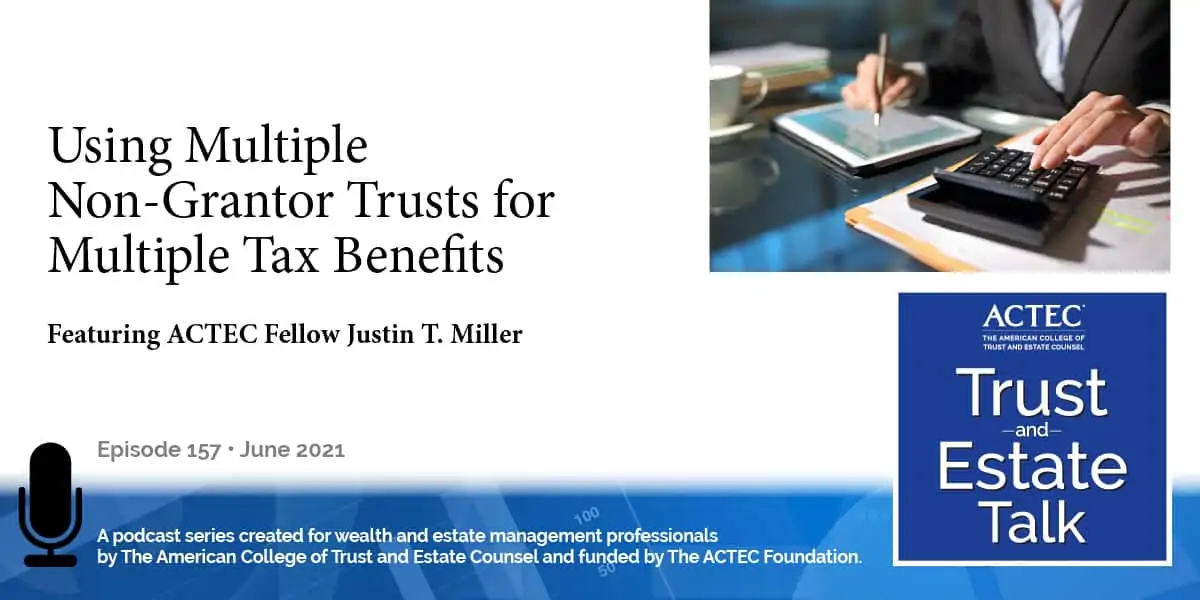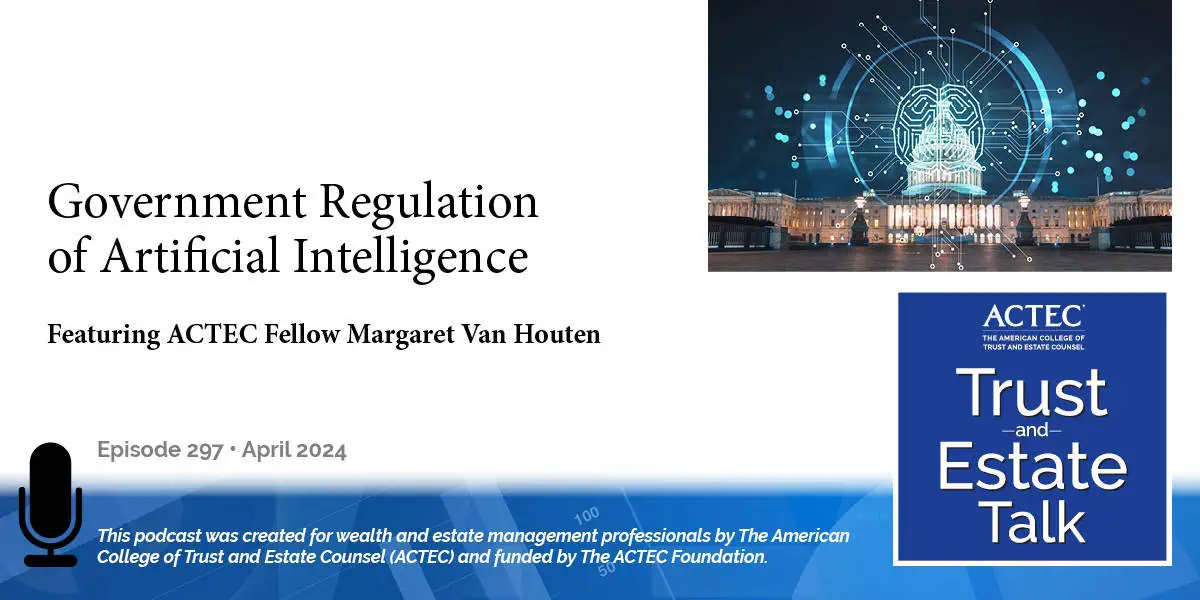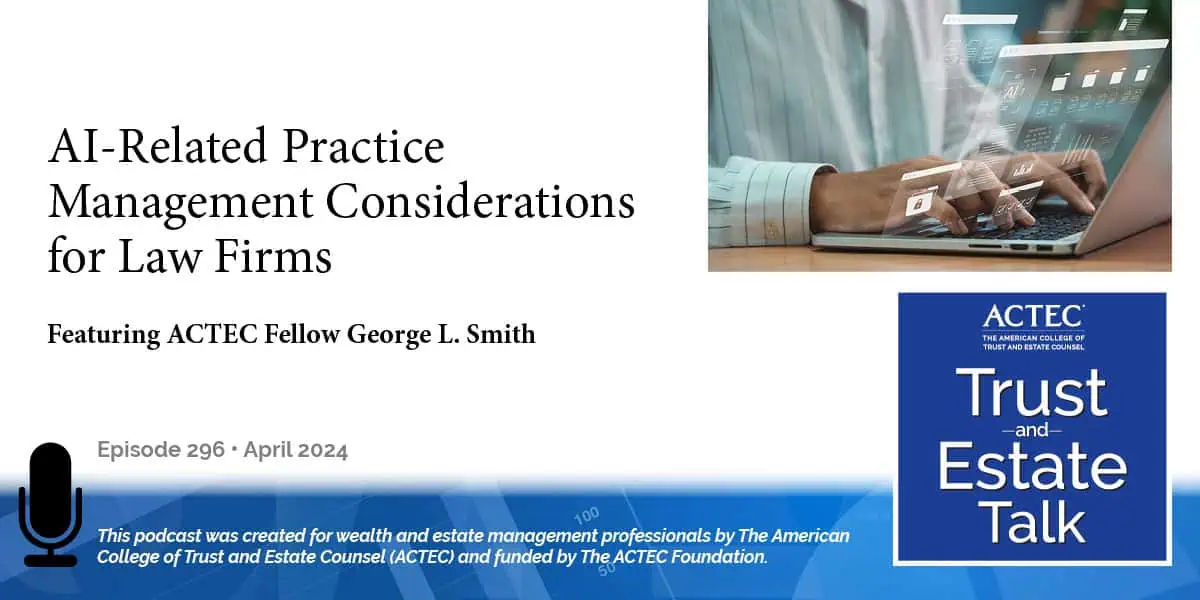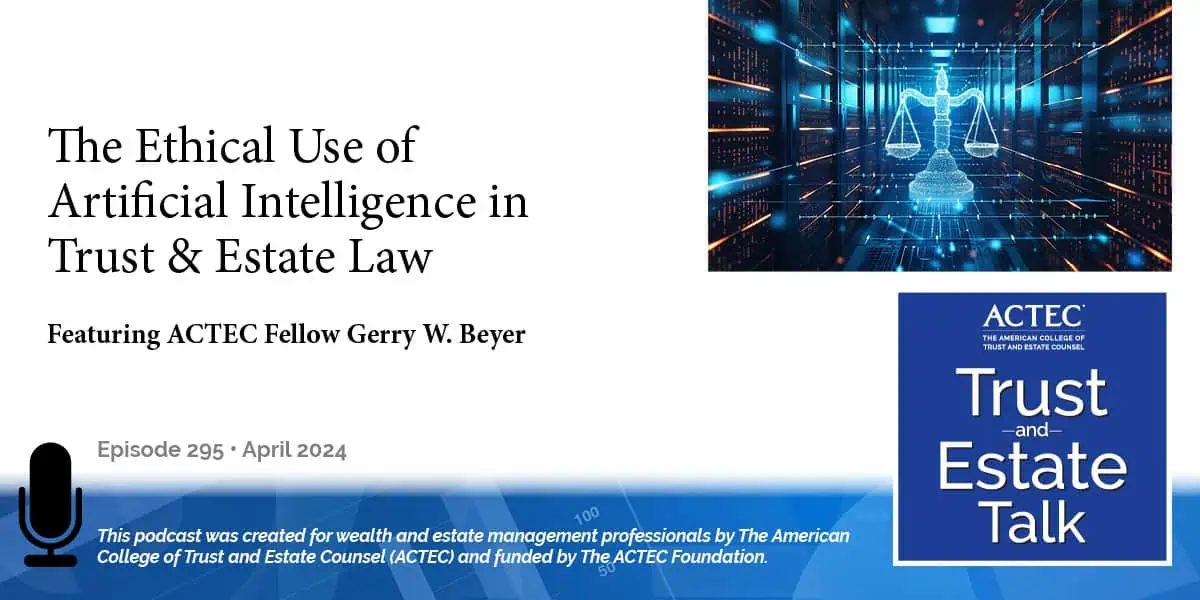Using Multiple Non-Grantor Trusts for Multiple Tax Benefits

“Using Multiple Non-Grantor Trusts for Multiple Tax Benefits,” that’s the subject of today’s ACTEC Trust and Estate Talk.
Transcript/Show Notes
This is Ed Beckwith, ACTEC Fellow from Washington, DC. Why clients use multiple grantor trusts. To learn more about this topic, you’ll be hearing today from ACTEC Fellow Justin Miller of San Francisco. Welcome, Justin.
Thank you so much. And let me start with – when it comes to multigenerational tax planning for wealthy families, Intentionally Defective Grantor Trusts, or IDGTs, are the traditional bread and butter strategy for most trust and estate attorneys. And don’t get me wrong. They are fantastic from a gift, estate and GST tax perspective. The grantor pays the income taxes for the IDGT, which isn’t treated as a gift for tax purposes, and which allows the IDGT to basically grow tax free for future generations, completely free of any future gift or GST taxes. And there’s plenty of support with Revenue Rulings such as 85-13, 2004-64, and 2008-22. But what about non-grantor trusts? Why are they becoming increasingly popular? And why would anyone want to create multiple non-grantor trusts?
Background on Non-Grantor Trusts
So, let me start with a little background. Trust and estate planning attorneys have been doing fancy trust planning in this country for a very long time. And back when income taxes were as high as 94 percent, non-grantor trusts were a great way for taxpayers to shift income from their high tax bracket into lower income tax brackets. And by the way, Congress was aware of this at least as early as 1937. There’s evidence of this with hearings before the Joint Committee on Tax Evasion and Avoidance back in 1937. In fact, President FDR, in his message to Congress, mentioned this type of multiple trust planning for tax benefits. But not much was done at the congressional level.
And in fact, there is a famous case, the Estelle Morris Trust case. It was a tax court case in 1968. It was affirmed by the Ninth Circuit in 1970, and it kind of showed the extreme level that taxpayers were going to in order to take advantage of these different tax brackets, using multiple trusts. In the Estelle Morris Trust case, there were 20 different trusts created by 10 virtually identical, separate trust instruments. Now, there were minor differences with the trust instruments. They had some different periods of time for income accumulation and distributions, some different termination dates; but other than that, they were virtually identical.
So, we have 20 different trusts, 10 virtually identical trust instruments. And the court looked at this and said, you know what? It’s clear that this is being done for tax avoidance purposes. Without a doubt. There would be no other reason to do 20 different trusts in this case. However, the court went on to say, you know what? Congress is aware that this exists. The president knows this exists. They went back all the way to 1937 and said, you know, if Congress really had a problem with taxpayers doing these types of multiple trusts, they could always say it’s not allowed. And it went on to say that as judges, they, especially in this case, did not want to use these judicially-created doctrines such as sham transaction or step transaction to say that this was inappropriate or illegal or against the law because Congress was aware this was going on, and they did nothing about it. So, as far as the judges were concerned in this case, the court said, if Congress doesn’t like it, they can change the law. It’s not up to judges to legislate.
So, that’s what the decision was in 1970. And at the time, it still made sense to do this type of multiple trust planning. And so, after that point in 1970, in typical congressional fashion, it took a very long time, but a change eventually did come about. We got the Tax Reform Act of 1984, and Congress passed what is now known as Section 643(f), which is our multiple trust rule. And 643(f), more or less, says that if you have two or more trusts, they are going to be treated as one trust if you have substantially the same grantors, and substantially the same primary beneficiaries, and the principal purpose is avoidance of tax. And the Section goes on to say, we’re going to treat spouses as one person under Section 643(f).
So, finally in 1984, we get this new Code Section saying we are going to treat multiple trusts as one trust, but it’s limited to if you have substantially the same grantors, substantially the same beneficiary or beneficiaries, and your principal purpose is avoidance of tax. Then, a couple years later, we get the Tax Reform Act of 1986 where we start to get these special, compressed tax brackets for trusts and estates. And it was further reduced, the benefit of doing these multiple trusts, by the Revenue Reconciliation Acts in 1990 and 1993. And what we see now are these compressed tax brackets. It doesn’t really make much sense in a lot of situations to create multiple trusts because trusts are in the highest tax bracket.
For income tax purposes, it’s such a low level. To put it in perspective for 2021, at just over $13,000.00, trusts and estates are in the highest tax bracket compared to, let’s say, individuals that aren’t in the highest tax bracket for 2021 until $523,600.00. For joint filers, they are not in the highest tax bracket until $628,300.00. Trust and estates – they are in the highest tax bracket, like I said, just over $13,000.00. So, there’s no longer the same motivation to do these multiple trusts to take advantage of lower tax brackets because trusts and estates most often are in the highest tax bracket so quickly once that income just hits over that $13,000.00 level for 2021.
Five Reasons Why Non-Grantor Trusts Make Sense in 2021
So, why would we still care about it? If anything, with the 643(f) and these new compressed tax brackets after 1986, why would we even continue to do these non-grantor trusts, let alone multiple non-grantor trusts? Well, I’m going to give you five reasons. Five reasons why non-grantor trusts could make sense in the right set of circumstances, and why you still might want to do more than one non-grantor trust. So, let me start with No. 1; and that is, reason to do a non-grantor trust is that the grantor with the non-grantor trust does not have to pay the steep income taxes for a non-grantor trust.
Now, as I started off today’s conversation, oftentimes you want the grantor to pay the income taxes because it’s almost like a tax-free gift. But you do sometimes have grantors – that they don’t want to pay the taxes for the trust. Maybe they don’t want to take out of their own estate and their own cash flow and provide more money for children and grandchildren down the road. They might be somewhat illiquid and not have the cash on hand to make those income tax payments, or they simply just don’t want to do it. And in that case, a non-grantor trust would make sense. The non-grantor trust would be its own sort of tax paying entity if you will. And so, that would be one reason the grantor does not want to pay income taxes. So, don’t do a grantor trust. Do a non-grantor trust.
The other big reason, No. 2, is to avoid, or at least minimize, or even defer state income taxes. So, let’s just say for example, California with state income tax rates as high as 13.3 percent. If you set up a non-grantor trust in a state like Delaware, Nevada, Alaska, Texas, Florida, Washington, the whole idea is having that trust, non-grantor trust in another state, you don’t have to pay California taxes. Now, we’ve got to be careful about state tax rules. There are sourcing issues. So, if it’s from a California source, you’d still have to owe taxes there. You have to be careful about having discretionary beneficiaries. You have to be careful about where the fiduciaries are located; and you also have to be careful, especially with states like California and New York. There’s a throwback tax. So, if and when the trust that’s out of state actually gives money to a California or New York resident, there could be a throwback tax at that time. Hey, at the very least, you have the benefit of interest free, penalty free tax deferral. So, out of state non-grantor trusts help in that regard.
The third reason has to do with something that came about as part of the Tax Cuts and Jobs Act, and that is the new Section 199 Capital A Deduction. That’s the 20 percent deduction for qualified business income. Now, normally for individuals, it’s limited or phased out, subject to certain wage and asset tests, once taxable income starts to exceed in 2021 just over $164,900.00. And that’s the tax for individuals. But every non-grantor trust gets its own phase-out limit. So, if we’re not meeting the wage and asset test, what we could do is set up multiple non-grantor trusts to own those qualified businesses, and each one of those non-grantor trusts gets its own Section 199A, 20 percent deduction, and its own phase-out limit.
Another Tax Cut and Jobs Act benefit, and this is the No. 4 benefit for doing non-grantor trusts, has to do with the state and local tax, the SALT limitation. What happened with the Tax Cuts and Jobs Act is we now have this new $10,000 limitation on deducting state and local taxes. So, if you’re in a state like California, where many people don’t get any benefit from their property taxes because their income taxes are so high and therefore, they’re already limited to that $10,000 number; let’s say they own a personal residence that requires $40,000 in property taxes every year. And they won’t get any kind of state and local deduction benefit for federal purposes because of that $10,000 limitation. Well, what they could do is create four trusts. Let’s say I have four children. I could then put my house into trust for each of those children, and in theory, each of those non-grantor trusts will get its own $10,000 state and local tax deduction.
The fifth reason is probably the biggest potential tax benefit of using non-grantor trusts, let alone multiple non-grantor trusts. And if you’ve got the right client who is able to take advantage of the benefit for qualified small business stock under Section 1202, non-grantor trusts could be one of the best, not only income tax planning tools, but gift, estate and GST tax planning tools as well. And so, what do I mean by that? Well, what Section 1202 provides is that if you have a qualified small business, and let’s say you’re a founder or an investor, and it’s got all these rules about being a C corporation, and this $50 million gross asset test. But if it qualifies, and you are that founder or investor, you get a 100 percent exclusion if you’ve acquired that stock after September 27, 2010, and you hold it for more than five years. There’s a special rollover rule, but if you qualify, that 100 percent exclusion after September 27, 2010 applies to the greater of $10 million or ten times basis.
Now, for a lot of founders, they don’t really have much basis in their stock. So, let’s say their own personal exclusion is $10 million. And so, let’s say we’re looking at something a founder started after September 27, 2010, and that company is now going public, or it’s being acquired. And it’s being acquired for tens of millions of dollars. Not only can that individual exclude $10 million, but let’s say the individual has four children. Then you could set up four non-grantor trusts, one for each child, and each non-grantor trust would get its own $10 million exclusion. So, if I’m the founder, not only would I qualify for $10 million of QSBS exclusion from federal income tax, but I’ve now excluded another $40 million in these trusts for each of my kids because of this special QSBS 1202 Rule for multiple non-grantor trusts. And each trust is for a different child. So, it’s not substantially the same beneficiary.
So, it could be an incredible planning tool. And by the way, I can take it one step further and set up these trusts, let’s say, in a state without state income taxes like Delaware, Nevada, Alaska, Florida, Texas, Washington, South Dakota, Wyoming. You name it. And if I’m, let’s say, in California, it’s another way to avoid, or at least minimize, or defer California state income tax. Once again, as long as we pay attention to the fiduciary and contingent beneficiary rules and also pay attention to sourcing and potential throwbacks. But not only would I possibly avoid the 10 million per non-grantor trust for federal income tax purposes, but we could get a state income tax benefit as well. And by the way, these are completed gift trusts. So, eventually all that money can go to kids, maybe even grandkids and beyond, completely free of gift, estate, and GST taxes.
So, with all that, why limit it if I have four kids? Why only do four trusts? Why don’t I do kind of like the Estelle Morris Trust case – 10 trusts, 20 trusts? How different do I have to make these trusts, so they’re not treated as one trust under 643(f)?
Recent Regulation Regarding Multiple Non-Grantor Trusts
Well, with that, let’s look at some recent regulations. What’s really scary from a planning perspective is Treasury came out with proposed regulations under 643(f). In those proposed regulations, we are going to presume that your principal purpose was tax avoidance unless you can show that there was a significant nontax purpose for creating these multiple trusts that could not have been achieved without separate trusts. Now, any time you have a presumption like that, that’s putting the burden on the taxpayer, and it creates a lot of unknowns. How much of the nontax purpose do you need to have? Meaning, let’s say, I create my four trusts for my four different children. Well, in theory, maybe I could’ve created one trust for all four kids using separate shares. What if I create an additional trust for my grandchildren or my children and my nieces and nephews?
So, there are a lot of unknowns. Unfortunately, those proposed regulations were not made final in that form. The final regulations came out in February 2019. And good news is – from the tax planning perspective – is the final regulation; they removed that whole principal purpose being presumed. They removed all of that and simply just kind of restated what Section 643(f) already tells you – that look, if you have substantially the same grantor, or grantors, and substantially the same beneficiary, or beneficiaries, then we’ll treat it as a one trust if your principal purpose was tax avoidance. So, it really just kind of restated the tax code. So, as of now, as long as you’re making these trusts, non-grantor trusts, different enough, and you have not your principal purpose being tax avoidance, arguably you can do this multiple non-grantor trust planning and take advantage of potential great income tax planning as well as estate, gift and GST tax planning.
Now, can you get any comfort? How close can you make these trusts? Is it possible to get a private letter ruling if you’re unsure? Is there any way you can get confidence to make you and your clients feel safe and secure? How does that work? Well, unfortunately, the IRS and Treasury don’t really give us any good guidance. We have – that just came out in January 2021 – Revenue Procedure 2021-3. And what’s in Revenue Procedure 2021-3 is the new addition of multiple trusts being added to the no ruling list. What that means is the IRS looked at 643(f) and said, you know what? Taxpayers, even if you want us to give you comfort, even if you ask us for a private letter ruling, we are not going to give you a private letter ruling on multiple trusts. Whether it works, whether it doesn’t work.
Now, this no ruling list. It doesn’t mean that it’s wrong, that it’s inappropriate, that it’s illegal. It just means that the IRS is looking into the issue, and they just don’t want to come out and bless the transaction. But at the same time, they’re not coming out and saying you cannot do it. They just don’t want to tell you that you can do it. So, out of an abundance of caution, if you are doing more than one non-grantor trust, you just need to be certain in your planning to try to make them as different as possible to comply with at least the letter of the law under 643(f). And so, with that, I hope this information helps you. I hope it helps your client, and I thank you for your time. I hope you enjoy the rest of your day.
Thank you, Justin, for educating us on the tax benefits of utilizing multiple non-grantor trusts.
This podcast was produced by The American College of Trust and Estate Counsel, ACTEC. Listeners, including professionals, should under no circumstances rely upon this information as a substitute for their own research or for obtaining specific legal or tax advice from their own counsel. The material in this podcast is for information purposes only and is not intended to and should not be treated as legal advice or tax advice. The views expressed are those of speakers as of the date noted and not necessarily those of ACTEC or any speaker’s employer or firm. The information, opinions, and recommendations presented in this Podcast are for general information only and any reliance on the information provided in this Podcast is done at your own risk. The entire contents and design of this Podcast, are the property of ACTEC, or used by ACTEC with permission, and are protected under U.S. and international copyright and trademark laws. Except as otherwise provided herein, users of this Podcast may save and use information contained in the Podcast only for personal or other non-commercial, educational purposes. No other use, including, without limitation, reproduction, retransmission or editing, of this Podcast may be made without the prior written permission of The American College of Trust and Estate Counsel.
If you have ideas for a future ACTEC Trust & Estate Talk topic, please contact us at ACTECpodcast@ACTEC.org.
© 2018 – 2024 The American College of Trust and Estate Counsel. All rights reserved.
Latest ACTEC Trust and Estate Talk Podcasts

Government Regulation of Artificial Intelligence
Rapid growth of AI demands government regulation to safeguard against misuse of private data. Global efforts are underway to address this critical issue.

AI-Related Practice Management Considerations for Law Firms
A discussion for law firms about how to incorporate AI in their practice management, including staff considerations, the “billable hour,” and more.

The Ethical Use of Artificial Intelligence in Trust & Estate Law
A law professor offers insights into the risks, rewards, duties and ethical considerations of lawyers using AI in their T&E practices.

